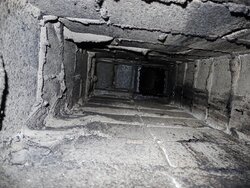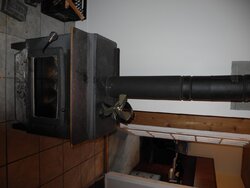Hi All,
Just moved into my first home with a wood stove and have been learning as much as I can but glad I found this site and others. Obviously being a beginner i've had some smouldering fires and less then perfect but i'm learning to burn it hotter. Now the landlord said she cleaned the chimney, and maybe she did, but after talking with family who have had chimney fires before they warned to be careful. Anyhow today I took off the bottom plate on my chimney and took a picture up the chimney. I've attached it and it seems like quite a bit of creosite, almost thought it was bad cement laying, but I have no point of reference as this is my first stove. This is obviously the bottom of the chimney so can really tell what's going on where the pipe actually meets the chimney but it looks very black and tarry up there. Should I be worried and get the landlord to do another cleaning? Unfortunately had to buy wood in December so it's not perfectly seasoned but it's also not bad too wet and burns well. I also have a lot of crusty stuff at the bottom which I presume is creosote from the hotter fires I've been burning falling off. Thanks for any help.
Just moved into my first home with a wood stove and have been learning as much as I can but glad I found this site and others. Obviously being a beginner i've had some smouldering fires and less then perfect but i'm learning to burn it hotter. Now the landlord said she cleaned the chimney, and maybe she did, but after talking with family who have had chimney fires before they warned to be careful. Anyhow today I took off the bottom plate on my chimney and took a picture up the chimney. I've attached it and it seems like quite a bit of creosite, almost thought it was bad cement laying, but I have no point of reference as this is my first stove. This is obviously the bottom of the chimney so can really tell what's going on where the pipe actually meets the chimney but it looks very black and tarry up there. Should I be worried and get the landlord to do another cleaning? Unfortunately had to buy wood in December so it's not perfectly seasoned but it's also not bad too wet and burns well. I also have a lot of crusty stuff at the bottom which I presume is creosote from the hotter fires I've been burning falling off. Thanks for any help.



